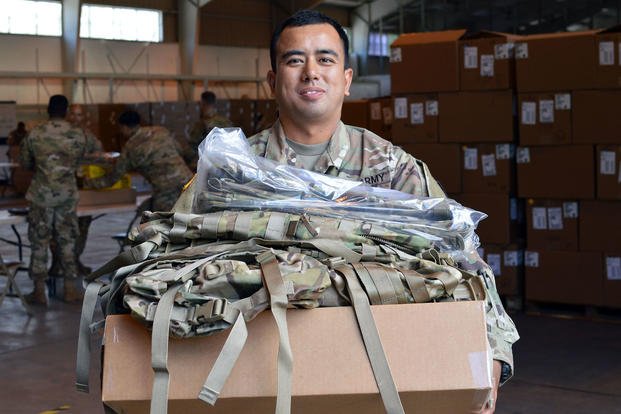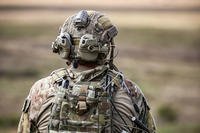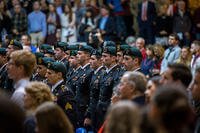The traditions of the United States Army, including its uniform and accoutrements, are rooted in the British Army of the 18th century. Clothing of this period was characterized by tightly fitted smallclothes (waistcoat and breeches) and coats with tight-fitted sleeves. Generally speaking, each soldier received a uniform consisting of a wool regimental coat with linen smallclothes in the spring, and a wool regimental coat with woolen smallclothes in the fall.
Regulations published in 1779 established the Army uniform as blue with colored facings based on region: white for New England, red for the Mid-Atlantic, and blue for the South. Musicians wore uniform coats in reverse colors. In 1782, blue coats faced with red became standard for everyone except generals and staff officers.
Army Uniforms: Early America (1786-1833)
The year 1812 was a very confusing one in regard to uniforms. Because of a shortage of blue cloth, coatees made of drab, black, brown or gray cloth were issued to various Regular Army infantry regiments during the winter of 1812-13. These were made in the same manner as the regulation coatee with red cuffs and collar -- and, in most cases, with the white binding. (The 25th through 28th Infantry Regiments received blue coatees with red cuffs and collar, but with white binding lace on the collar only.) In February 1813, the white binding was dropped altogether.
In May 1813, uniform regulations were revised again. The new uniform coatee was single-breasted with a 10-button closure in front. The red collar and cuffs were eliminated, and lace binding was to be on the collar only in either white for infantry or yellow for artillery. The regulations also introduced a new cap or shako copied directly from the Belgic-type cap worn by the British Infantry. This uniform remained in service with only minor alterations into the 1820s.
Army Uniforms: Mid-19th Century (1833-50)
Changes to the Army structure prompted changes to the uniform regulations. The uniform coatee introduced by the regulations of 1833 was not much different than its predecessors. It was single-breasted for privates with nine buttons in front and lace on the collar. The buttons were of a new pattern, and worsted epaulettes replaced the shoulder wings used previously. The wool lace continued to be white for infantry and yellow for artillery. The new regiment of dragoons also received yellow lace.
Branch insignia was introduced although the metal color continued to be yellow for mounted soldiers and white for foot troops. The new branch insignia authorized in 1833 included an eagle with a hunting horn for infantry and an eagle with crossed gun tubes for artillery. The regiment of light dragoons received a bi-metal insignia consisting of a yellow federal eagle on a white metal sunburst.
Army Uniforms: Mid-19th Century (1851-72)
The uniforms introduced under the regulations of 1851 were relatively short-lived, but the changes that were made were significant for the Army. The frock coat was introduced as the service uniform for all soldiers, thus eliminating the coatee. A system of branch colors was introduced: Prussian blue for infantry, scarlet for artillery, orange for dragoons, green for mounted rifles and black for staff.
The regulations of 1858 and '60 established the uniform that defined the Union soldier in the American Civil War: the Army hat in black felt with appropriate branch insignia; the frock coat with branch piping for foot troops; uniform jackets with branch-colored lace for mounted troops; and sky-blue trousers. In addition, a four-button, blue wool sack coat and a forage cap (sometimes referred to as a "kepi") were authorized for fatigue and field wear.
Army Uniforms: Late 19th Century (1872-1902)
During this period, the Army made significant changes based upon field experience and recommendations. For field service, the Army adopted the "Swiss blouse" recommended by Assistant Surgeon Alexander Woodhull. The distinctive feature of this garment was four pleats running down each side in front from the shoulders to the bottom of the skirt. The purpose of the pleats was quite revolutionary, introducing the concept of layering. The coat was loose enough that it could be worn with up to three wool shirts and a waistcoat in cold weather and still allow for freedom of movement. This coat was despised almost universally by the average soldier, particularly those serving on the western frontier, and the concept of layering would not be revived by the Quartermaster Department until World War II.
Army Uniforms: Early 20th Century (1902-26)
From 1902-04, the Army introduced a staggering variety of rank, branch and specialist insignia in either bright colors for full dress and drab or bronze colors for the field, far more than we can deal with in this study. World War I broke out in August 1914 and almost immediately had an impact on Army uniforms. Most notable was the color change to the wool service uniform because of the non-availability of German dyed wool. (American manufacturers could not match the German formula for the olive drab color.)
Army Uniforms: Mid-20th Century (1926-56)
In 1938, summer and winter service breeches were eliminated except for soldiers engaged in mounted duties. They were replaced with the Pattern 1937 service trousers, in olive drab light shade wool serge for winter and cotton khaki for summer. The specifications for the wool and khaki shirts were modified.
With millions of men and women in uniform, the amount of insignia used by the Army grew dramatically, reflecting the large and complex structure of the force. Technician grades were added to the rank structure in 1942 and were reflected by a "T" centered below the chevrons. A T/5 was equal to a corporal, a T/4 to a sergeant and a T/3 to a staff sergeant; however, the ranks were not considered to be NCOs in a leadership sense.
In May 1941, it was announced that the blue denim fatigue uniform would be phased out and replaced with an olive drab, herringbone cotton twill uniform. The new uniform was single-breasted with five black metal tack buttons in front, plus a waist band with two additional buttons. The jacket also had a notched lapel with a fall collar, and two patch-type breast pockets with a split pleat in the center and a flap secured by a single metal tack button.
The uniform was intended for fatigue and field use. In November 1942, an improved version was released. Based on field experience, the breast pockets were made larger with a bellows gusset on the outer edge, and the waistband was eliminated. Treated with an anti-vesicant compound, HBTs were also used as chemical protective garments, particularly during the Invasion of France in June 1944. In March 1943, a specification change was made, changing the color of HBTs to a darker olive drab shade 7.
In the early 1950s, the Army asked Hattie Carnegie, a popular fashion designer, to restyle the Women's Army Corps service uniform. The wool serge, taupe jacket she designed "had a high, round collar, slightly padded shoulders and a nipped-in waist." The tailoring of the matching skirt became more feminine with rounded hips and a calf-length hem. The uniform was worn with a tan shirtwaist, cafe brown oxfords or pumps, and a matching service hat. Manufacture and issue of the new uniform began in 1952, and its reception by the members of the WAC was generally less than favorable.
Army Uniforms: Late 20th, Early 21st Century (1954-2006)
In 1954, the Army began to make changes to the uniform that it had been contemplating since just after the end of World War II. One of the most significant factors affecting decisions made about the new uniforms was the philosophy embraced by the Army leadership that officers and enlisted uniforms should be the same, distinguished only by insignia. Although the changes began in 1954, it would take until the end of the decade before they were implemented fully.
On Sept. 2, 1954, the adoption of the Army green uniform in shade 44 was announced, but it was not until September 1956 that it became available at Quartermaster Clothing Sales Stores -- and late 1957 before it began being issued to inductees. After a transition period to allow wear-out of existing uniforms, the green uniform became mandatory service dress in September 1961.
In 1963, tropical combat clothing was classified for production and issued to soldiers serving in Vietnam. There were three basic patterns of tropical combat coats. The first was made of olive green shade 107, wind resistant cotton poplin with two slanted bellows-type breast pockets and two bellows-type lower pockets on the coat. The pockets had flaps secured by two exposed plastic buttons, an interior button over gas flap, shoulder loops and a double button adjustment tab on each side at the waist. The second pattern coat was basically the same as the first pattern, except that all buttons were covered to prevent snagging in jungle terrain.
On Oct. 1, 1981, the Army introduced the battle dress uniform, or BDUs. This uniform was descended from the tropical combat uniform of the Vietnam War and consisted of a coat made of a nylon and cotton blend in woodland pattern camouflage with matching trousers, and a field cap. Because combat experience in Grenada showed that the BDU uniform was too hot for tropical climates, the Army authorized the wearing of the old tropical combat uniform for several years while adjustments were made.
Army Uniforms: Present Day
For many years, almost every branch includes digital camouflage in their uniforms. This trend began with the Marines who were unwilling to share the design -- so much so that USMC was interwoven into the pattern to prevent other branches adopting it outright. The Army responded by investing millions of dollars in a custom version of the digital camouflage that raised some contention with the Marines.
The services have moved away from that system, however, with the Army, Air Force and Space Force using the Operational Camouflage Pattern (OCP), which originated with the Army in 2015.
Want to Know More About the Army?
Be sure to get the latest news about the Army, as well as critical info about how to join and all the benefits of service. Subscribe to Military.com and receive customized updates delivered straight to your inbox.















